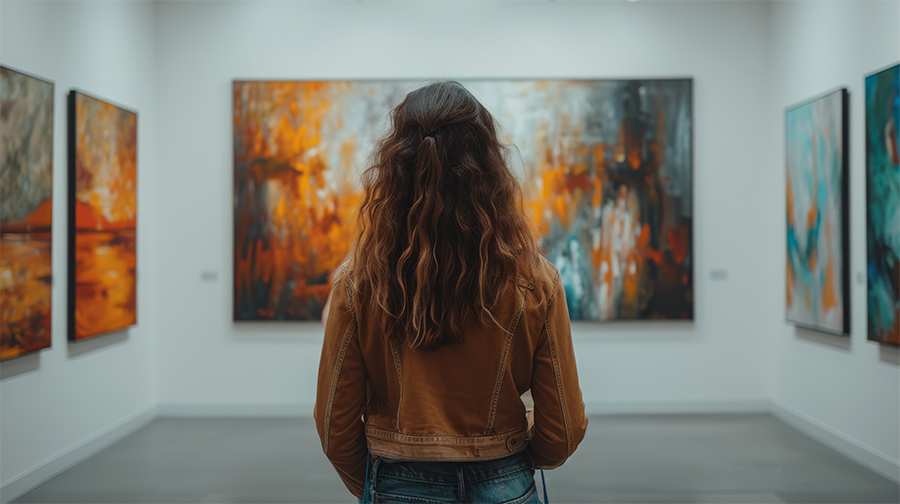While strolling around a museum, exhibit or educational pop-up, you may have wondered if these places may use artistic works however they see fit. As you probably know, museums and cultural institutions rely heavily on images to tell stories and educate audiences. But are all those copyrighted images in exhibits fair game? Well, it depends.
Creators may hold a copyright to their work if it is (1) original, (2) created with at least minimal creativity, and (3) fixed in a tangible form, such as a photograph, painting, manuscript, video, or audio recording. Copyright arises automatically upon creation, thus, there is no requirement to register a copyright for protection to exist. However, registering a copyright provides legal benefits, like the right to sue for infringement and claim statutory damages.
Sometimes museums and exhibitions may display copyrighted work without gaining permission or a license from the copyright holder. How? That’s due to a legal doctrine called “fair use.”
How can museums and educational institutions exhibit works without licensing them?
If a work is under copyright protection, using it without permission can lead to legal issues—unless an exception applies. Copyright typically lasts for the life of the author plus 70 years, though this varies depending on factors like when the work was created and published.
One of the exceptions to the rights granted to copyright owners is the fair use exception, which permits the use of copyrighted material “for purposes such as criticism, comment, news reporting, teaching, scholarship, or research.” A finding of fair use is determined by four factors: (1) purpose and character of the use in question; (2) the nature of the copyrighted work; (3) the amount and substantiality of the portion used; and (4) the effect on the market of the copyrighted work.
Because museums and other exhibits typically aim to educate the public and preserve culture, some of their use of copyrighted material may fall under fair use. Here’s a breakdown on why:
- Purpose and Character of the Use
Courts are more likely to find fair use if the work is used for non-commercial, educational, or historical purposes. This is especially true if the use is “transformative”—meaning it adds a new character, meaning or context—such as when a museum uses a painting to analyze its influence on later generations, or to examine its historical context.
Courts often find a museum or exhibit’s purpose for displaying a copyrighted work differs from the original purpose of the work. A museum’s purpose may be to provide historical context—not to sell the work—while the original creator’s intent may have been to market the work as art, entertainment, or merchandise. This difference often weighs in favor of fair use.
- Nature of the Copyrighted Work
The second factor involves what kind of work is being used, whether factual or creative, published or unpublished. The use of factual works like magazines is more likely to be considered fair use than using fictional or purely creative works like novels or paintings. However, even creative works may be used under fair use if the other factors weigh in favor.
Meanwhile, unpublished works, like an unreleased book, are entitled to greater protection as opposed to published works.
- Amount and Substantiality of the Portion Used
Using only as much of the work as necessary for the educational or critical purpose strengthens a fair use argument. Of course, sometimes, using an entire image is unavoidable—such as when a museum displays a painting. This may still constitute fair use if the use is transformative, the work is informational, and the amount of use is reasonable in relation to the purpose.
- Effect on the Market
The last factor is whether the museum or exhibit’s use of the work competes with or harms the market for the original work. If the museum’s use serves as a substitute for the original, harming its market, it is probably not fair use—in short, the use should not compete with the original work or reduce its demand.
A museum display of an artist’s work will often pass this test because an educational exhibit is unlikely to substitute for buying a piece of art. If the use is for a nonprofit educational purpose, it will not likely affect the creator’s market because it is not meant to sell or advertise a work.
Other Ways Museums Use Images Legally
Fair use isn’t the only pathway for museums or exhibits to display copyrighted works. Institutions may also license the rights from copyright holders or agencies, or simply use works that are in the public domain.
If you have questions or would like to discuss copyright concerns, please contact EPGD Business Law in Miami, Florida, at (786) 837-6787 or email us to schedule a consultation.
EPGD Business Law is located in beautiful Coral Gables. Call us at (786) 837-6787, or contact us through the website to schedule a consultation.


